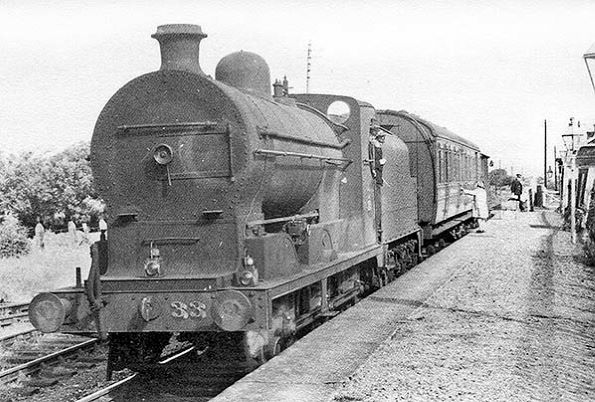 A local service for Strabane is seen at Porthall in 1963. Forming the motive power for this short train is UTA 0-6-0 SG class locomotive number 33. A local service for Strabane is seen at Porthall in 1963. Forming the motive power for this short train is UTA 0-6-0 SG class locomotive number 33.
Photo by L Hyland.
Porthall is a small settlement, on the west side of the River Foyle, in a sparsely populated rural area of County Donegal, Ireland. In 1845 the Londonderry & Enniskillen Railway (L&ER) was authorised to build a 59 mile line between the city of Derry/Londonderry and Enniskillen and work began in October that year. Construction started from Derry/Londonderry and the course of the line followed the west bank of the River Foyle, passing through Porthall, to Strabane, The first 14 miles of the single track L&ER line, between Londonderry (Gallows Strand) and Strabane, opened on 19 April 1847. At the time of opening there were three intermediate stations (Carrigans, St Johnston and Carrickmore).
Carrickmore was the nearest station to Porthall being 1¾ miles to the north. However there must have been a demand for a station at Porthall, because just over a year after the line had opened, in May 1848, one was provided. The station at Porthall was located just to the south of the Hollybush Park road which passed over the line by means of a level crossing. It is not known what the facilities consisted of at the time of opening but they are likely to have been quite basic.
The time table for March 1850 shows Porthall as having four trains in each direction. Monday-to-Saturday there were up trains (southbound) to Strabane at 7.05am (the Sligo Mail), 9.35am, 2.05pm and 4.35pm (the Dublin Mail). The journey time to Strabane was 10 minutes. Monday-to-Saturday down trains (northbound) to Londonderry (Gallows Strand) departed at 7.47am (The Dublin Mail), 10.22am, 2.52pm and 5.17pm (The Sligo Mail). The journey time to Derry/Londonderry was 38 minutes. On Sundays there were two trains each way.
The Derry/Londonderry terminus at Gallows Strand was a mile from the centre of the city and was therefore inconvenient for both passengers and goods. The L&ER opened an extension to a new station, located at Foyle Road close to the centre of the city, on 18 April 1850.
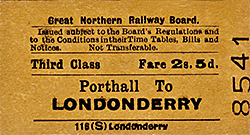 The first section of the L&ER line did not live up to financial expectations and that made progress with the southwards extensions difficult. The first extension south from Strabane opened to Newtownstewart on 9 May 1852 and a few months later, on 13 September 1852, Omagh was reached. The first section of the L&ER line did not live up to financial expectations and that made progress with the southwards extensions difficult. The first extension south from Strabane opened to Newtownstewart on 9 May 1852 and a few months later, on 13 September 1852, Omagh was reached.
On 19 August 1854 the L&ER finally reached Enniskillen.
In February 1859 the Dundalk & Enniskillen Railway (D&ER) reached Enniskillen. This changed things for the L&ER line as it was now connected to Ireland’s capital city Dublin as part of a trunk route. The L&ER realised that more efficient running of train services could be brought about if both lines were worked by one company. They entered into negotiations with the D&ER and from 1 January 1860 that company took out a lease on the L&ER line and started to operate the train services. This resulted in through running between Derry/Londonderry and Dundalk with through coaches to Dublin. On 2 September 1861 the Portadown, Dungannon & Omagh Railway completed its route which created a direct route to Belfast.
On 7 July 1862 the D&ER was renamed as the Irish North Western Railway (INWR).
In 1863 Porthall was now served by three trains in each direction.
On 13 March 1863 there was a tragic accident at Porthall station. The Station Master was giving some children a ride on a platelayers trolley (described as a lorry) when a pilot engine came along the line. The Station Master hoisted a red signal and managed to remove four children but a fifth was killed. It seems to have been a very foolhardy thing to do and it is not known what action, if any, was taken against the Station Master.
On 1 January 1876 agreement was reached for INWR to be taken over by the Northern Railway (Ireland) and in turn that company merged with the Ulster Railway to form the Great Northern Railway Ireland (GNRI) on 1 April 1876. In 1883 the GNRI bought out the L&ER lease.
In 1879 Porthall station reached its final form. The passenger facilities were located in a single storey brick built building with a pitched roof of slate. The building was located adjacent to the level crossing on the east side of the line. A path passed between the front of the building and the main line and connected to a raised platform which had a face of stone and a paved edge. Behind the paved edge the platform surface consisted of crushed stone. Oil lamps illuminated the platform which had been lengthened by 150 feet.
There was a goods siding with loading platform which was located on east side of the line.
Also in 1879 new sidings were put in to serve a small brick works and quarry. The new section of line branched off from the goods siding just to the north of the level crossing, before the loading platform.
The timetable of December 1895 showed Porthall as having 3 trains in each direction Monday-to-Saturday. In the Up direction there was a train at 7.10am for Strabane, at 2.01pm for Enniskillen and at 5.08pm for Clones. In the down direction all of the trains ran to Londonderry Foyle Road and they departed at 9.20am, 12.09am (by request only) and at 4.53pm. On Sundays there was only one train, at 9.53pm, which was an Up service to Belfast Great Victoria Street.
The 1904 Handbook of Station listed Porthall as being able to handle general goods, parcels and livestock.
On 4 August 1914 the British Empire declared war on Germany and entered the Great War. From 1 January 1917 the GNRI was taken into British Government control (along with all of the other Irish railways). The GNRI system was used intensely during the war years. Almost as soon as the fighting had stopped, on 11 November 1918, the Irish War of Independence broke out in January 1919. In early 1921 the British Government relinquished control of the GNRI and it was put back into the hands of its directors.
The line’s problems had not gone away, however, as by the end of 1921 Ireland was partitioned into two separate countries. As a company the GNRI now found itself operating in both. The line through Porthall between Londonderry Foyle Road and Strabane was particularly problematic. The intermediate stations of the route were all located in County Donegal which became part of the ‘Free State’. County Tyrone in which Strabane was located, and County Londonderry in which the city of Derry/Londonderry was located, both became part of Northern Ireland. This meant that customs checks had to be made for passengers and goods that were passing between the two countries. Customs facilities were provided at Porthall station and a ‘Free State’ customs officer was based there.
As if this wasn’t bad enough a Civil War broke out in The Irish Free State in June 1922. This caused further disruption to the railway in County Donegal and it went on until May 1923.
Despite the difficult operating issues facing the GNRI, the July 1922 timetable showed 3 Up and 4 Down services Monday-to-Saturday. In the Up direction there was an 11.39am train to Clones, a 2.53pm service to Dundalk and a 5.31pm train to Enniskillen. Down trains all ran to Londonderry Foyle Road departing from Porthall at 9.24am, 12.36am, 5.00pm and at 8.32pm. There was no Sunday service in 1922.
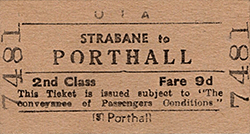 In order to make operations along the line through Porthall with regards to the border situation two important innovations were devised. Many longer distance passenger services ran non-stop between Derry/Londonderry and Strabane which meant that customs checks were not necessary. For goods that were coming into Porthall from other locations within the Irish Free State the wagons were sealed for their passage through Northern Ireland. Customs officials at Porthall could then check that the wagons had remained sealed. The same applied to outgoing goods. The practice was also adopted at St Johnston and Carrigans; this was known as “Free to Free” traffic. The limited goods traffic was mostly related to agricultural products and salmon fishing. In order to make operations along the line through Porthall with regards to the border situation two important innovations were devised. Many longer distance passenger services ran non-stop between Derry/Londonderry and Strabane which meant that customs checks were not necessary. For goods that were coming into Porthall from other locations within the Irish Free State the wagons were sealed for their passage through Northern Ireland. Customs officials at Porthall could then check that the wagons had remained sealed. The same applied to outgoing goods. The practice was also adopted at St Johnston and Carrigans; this was known as “Free to Free” traffic. The limited goods traffic was mostly related to agricultural products and salmon fishing.
The 1930s were difficult for the GNRI as they faced industrial unrest and increasing competition from road vehicles.
In 1938 on weekdays Porthall had 5 trains in each direction. There was also one service each way on a Sunday.
During the Second World War there was an upturn in traffic but owing to the Irish Free State being a neutral country maximum use of the route through Porthall could not be made as war materials and troop trains could not pass that way.
After the war ended in 1945 the railways of Northern Ireland were subjected to even more competition from road transport.
In 1949 Nationalisation came to the railways of Northern Ireland, with the notable exception of the GNRI. As the GNRI operated in two separate countries nationalisation of only part of it, that which was in Northern Ireland, would have proved to be difficult. The Ulster Transport Authority (UTA) was set up to run transport services within Northern Ireland (including buses and road haulage) and it very quickly showed itself to be a pro-road entity. On 15 January 1950 the entire system of the Belfast & County Down Railway was closed down on the same day, with the exception of branches to Bangor and Donaghadee. Other closures came thick and fast in 1950 when many former NCC lines were closed such as their narrow gauge lines in County Antrim and the former County Down branch to Donaghadee on 22 April 1950. The GNRI, having avoided nationalisation in both parts of Ireland by 1950, did not face the same levels of closure as the other railways of Northern Ireland but financially it was struggling and by 1953 it could no longer continue. From 1 September 1953 the governments of the Republic of Ireland (the Irish free State had become a full republic on Easter Monday 1949) and Northern Ireland formed the Great Northern Railway Board (GNRB). The board included equal representation from both governments. The Republic had nationalised all its railways under Córas Iompair Éireann (CIE) in 1950.
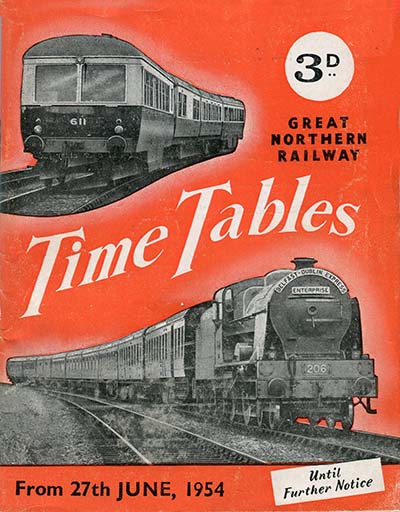 The summer timetable for 1954 showed 5 Up services Monday-to-Friday. The first Up train departed at 7.23am for Belfast Great Victoria Street. At 10.53am there was a train for Strabane followed by an Omagh service at 1.55pm. There was another Omagh service at 5.56pm and the final train of the day was a Belfast Great Victoria Street service at 7.06pm. On Saturdays there was an additional up train which departed at 11.36pm and ran to Victoria Bridge. In the Down direction there were 4 trains Monday-to-Saturday all of which ran to Londonderry Foyle Road. They departed from Porthall at 9.11am, 2.34pm, 6.21pm and 9.26pm. There were no Sunday services. The summer timetable for 1954 showed 5 Up services Monday-to-Friday. The first Up train departed at 7.23am for Belfast Great Victoria Street. At 10.53am there was a train for Strabane followed by an Omagh service at 1.55pm. There was another Omagh service at 5.56pm and the final train of the day was a Belfast Great Victoria Street service at 7.06pm. On Saturdays there was an additional up train which departed at 11.36pm and ran to Victoria Bridge. In the Down direction there were 4 trains Monday-to-Saturday all of which ran to Londonderry Foyle Road. They departed from Porthall at 9.11am, 2.34pm, 6.21pm and 9.26pm. There were no Sunday services.
The GNRB was unable to stop the losses, the Northern Ireland government was not of a mind to sustain them and economies started to be made. In 1956 Stormont had announced that there would be more closures, which included the route between Omagh and Enniskillen (part of the original route of the L&ER) and these lines, 115 miles in total, were closed during September/October 1957. These severe closures were opposed by the Dublin Government and the GNRB as being unrealistic and economically damaging. At the end of 1957 he Northern Ireland government at Stormont announced that it was going to end the agreement with Dublin that had created the GNRB in 1953.
At midnight on 30 September 1958 the GNRB ceased to exist when the ‘Board’ was wound up and the assets of the company were divided between the UTA of Northern Ireland and the CIE of The Republic of Ireland. The 8 miles long section of the Derry/Londonderry – Strabane line, that lay within the Republic of Ireland now passed into the hands of CIE. Staff at Porthall became CIE employees, at a station only served with public services operated by the UTA.
Porthall’s train services were operated by the UTA. By 1958 there were only 4 local trains in each direction Monday-to-Friday with an additional up service running to Victoria Bridge on Saturdays.
The UTA started to use ex-GNRI railcar A for the local services that served Porthall. The railcar had come into service in 1932 and would be renumbered as 101 by the UTA in October 1961. When Railcar 101 was not available, one of the two steam engines at Derry that had arrived with the night goods would operate these local services instead.
The timetable of September 1961 showed a reduced service to Porthall. There was a morning goods service from Strabane to Derry/Londonderry that was booked to call at Porthall daily, except on a Sunday. From Mondays-to-Saturdays there were two up passenger trains from Strabane to Londonderry Foyle Road that called at Porthall with an extra train to Derry/Londonderry on a Saturday evening only. Passenger services from Porthall to Strabane were reduced to just two passenger trains, both from Foyle Road, on weekdays only. There was also a mixed train from Foyle Road to Strabane Tuesday-to-Saturdays, that called at Porthall. By 1961 the goods sidings to the former brick works remained but had been cut back as the brick works had closed.
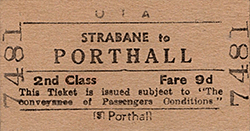 In 1962 the Northern Ireland government commissioned an enquiry into its railways. The enquiry was carried out by Colonel Henry Benson and on 17 July 1963 he published his report (which became known as the Benson Report). The report recommended the closure of the ‘Derry Road’ route. Tyrone County Council supported by other local authorities along the route attempted to stop the closure through dialogue with the Northern Ireland government and when that failed they resorted to court action against the plans of the UTA, who were following orders from Stormont. In 1962 the Northern Ireland government commissioned an enquiry into its railways. The enquiry was carried out by Colonel Henry Benson and on 17 July 1963 he published his report (which became known as the Benson Report). The report recommended the closure of the ‘Derry Road’ route. Tyrone County Council supported by other local authorities along the route attempted to stop the closure through dialogue with the Northern Ireland government and when that failed they resorted to court action against the plans of the UTA, who were following orders from Stormont.
From 15 June 1964 the UTA introduced their last summer timetable for services on the Derry Road. Porthall had no up passenger services Mondays-to-Fridays. The only up service was a Monday-to-Saturday goods that ran from St. Johnston to Strabane. On Saturdays Porthall had one up service, to Strabane, at 6.39pm. In the down direction there were 2 passenger trains Mondays-to-Fridays both of which ran to Londonderry Foyle Road. On Saturdays there were an extra 3 down passenger services (giving 5 trains in all). There was also a Monday-to-Saturday goods service from Strabane to St Johnston which called at Porthall until January 1965.
In the end the court action that was taken by Tyrone County Council was to fail and closure was announced for 4 January 1965. A second hearing merely staved off the closure for another 6 weeks for passengers only until 14 February 1965.
After the loss of the goods services from 4 January 1965 passenger trains still operated using the new winter timetable (introduced from 7 September 1964). There was still only the one up passenger service (to Strabane) on Saturdays but retimed to 6.32pm. In the down there was one down service to Londonderry Foyle Road at 2.19pm Mondays-to-Saturdays. There was also a down workman’s train Mondays-to-Fridays which ran from Strabane (departing at 6.00pm) and terminated at Porthall. This train returned as empty carriages to Strabane. It was steam hauled and as there were no run around facilities at Porthall the coach had to be propelled back to Strabane. On Saturdays there were 3 up trains (giving 4 in total) to Foyle Road. As there was no Sunday service at Porthall, the last passenger trains ran on Saturday 13 February 1965.
Track lifting took place in late 1965. The station building was subsequently demolished but both the passenger platform and the goods loading platform were extant in 2020. |

 Home
Page
Home
Page

 Home
Page
Home
Page